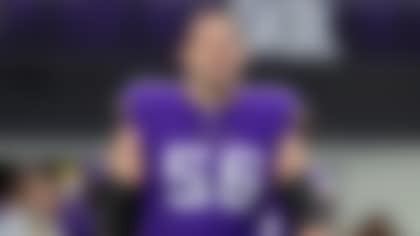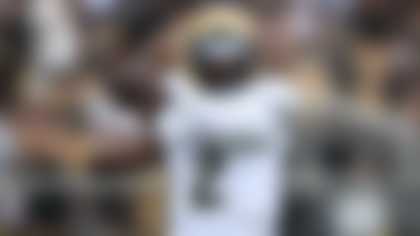If you happen to sit in the Sun Power Suite at Levi's Stadium during Super Bowl 50, you will see a tribute to Steve Jobs, Apple Founder and a man some call the most brilliant innovator of our generation. The tribute is simple -- a framed sketch of Jobs accompanied by one of his most famous quotes:
"The ones who are crazy enough to think they can change the world are the ones who do."
The tech-infused Levi's Stadium has a spot for Steve Jobs. (Austin Ginn/San Francisco 49ers)
Call the tribute appropriate. Levi's Stadium is in the heart of Silicon Valley -- and Silicon Valley is Steve Jobs country.
Google map it! The house where he invented the Apple Computer at 2066 Crist Drive in Los Altos is a mere 11 miles away from the home of Super Bowl 50. The spirit of innovation is in the air everywhere, but it's different in this neighborhood now. Steve is gone and the hometown 49ers will be watching the big game from the couch, a far different scene from the last time the Super Bowl was in the Bay Area -- that was 1985, when the Niners and Steve Jobs couldn't be stopped no matter how wild their ideas were.
* * * **
Let's travel back to January 1985 ...
Steve Jobs is in his Cupertino office (just 8.9 miles away from where Levi's Stadium stands today), basking in the glory of his recent success: the launch of the Macintosh personal computer. Sure, he is battling with the Apple board made up of the establishment he despises, but he can take solace in the fact that he was instrumental in bringing the "Mac" to market and making history with one of the most memorable Super Bowl commercials of all time): A one-minute spot airing in the third quarter of Super Bowl XVIII that featured a female runner throwing a sledgehammer at the establishment and shattering it.
The ad provokes people to run to the store and buy the latest Apple product, shattering sales records -- but Jobs wants more.
In the meantime, just 19.4 miles away, at 49ers headquarters in Redwood City, Bill Walsh is celebrating his own success, with one Super Bowl title already under his belt, a quarterback he's tutored to elite status in Joe Montana, and a football team that has rampaged its way back to the game's biggest stage. The 49ers have just finished the 1984 regular season with a 15-1 record -- the best mark since the NFL had gone to a 16-game slate in 1978 -- and cruised past the Giants and Bears in the playoffs to punch a ticket to a hometown Super Bowl at near-by Stanford Stadium.
Of course, this isn't the first time Jobs and Walsh have been simultaneously striving for goals that will define their respective legacies ...
* * * **
In 1979, the 49ers were much like Steve Jobs -- they believed in themselves and needed people to believe in them. It was the beginning of a parallel in the Bay Area between two powerhouses, The Team of the Decade and one of the true creative geniuses of our time. They would both travel incredible roads from that "prove yourself" year, both destined for greatness -- but every revolution has an initial spark.
In this final year of the '70s, the Silicon Valley is about to explode, and at the center of this once-apricot orchard and former vacation spot for well-to-do San Franciscans is Steve Jobs. Apple Computer is about to go public on the NASDAQ stock exchange, ensuring Jobs a net worth of millions.
Meanwhile, in nearby Redwood City, just 18 miles from Apple, Walsh is sitting with his rookie quarterback Joe Montana and fellow freshman Dwight Clark. The coach is at the chalkboard presenting play after play, unveiling a game-changing "West Coast Offense." One imagines Walsh diagramming "Red Right Tight -- Sprint Right Option," a play destined to change everything for everyone in the room.
On Dec. 12, 1980, Steve Jobs' Apple stock goes public. Just over a year later, Clark makes "The Catch" (on the aforementioned "Red Right Tight -- Sprint Right Option") and the 49ers go on to win their first Super Bowl. Jobs, Walsh and Montana are household names and national heroes.
* * * **
But let's get back to January 1985, when the 49ers and Jobs are both established, trying to stay on top. That's when their two worlds truly collide in Stanford Stadium, the site of the last Bay Area Super Bowl.
In January of 1985, hundreds of high school students -- including this writer -- are volunteering to put seat covers on the benches of the 100,000-plus capacity stadium. Emblazoned on the cushion is the logo for Apple Computers. A few miles away, Jobs is planning his 30th birthday party in February, knowing that the millions of viewers watching the nation's biggest television event are going to get a glimpse of his logo covering the Palo Alto benches. He decides, according to Walter Isaacson's book "Steve Jobs,") that his birthday invitation will read:
"There's an old Hindu saying that goes, 'In the first 30 years of your life, you make your habits; for the last 30 years of your life, your habits make you.' Come help celebrate mine."
Walsh's habit to win Super Bowls made him -- and on Jan. 20, 1985, he wins his second. By the end of Super Bowl XIX, those sitting on the Apple seat cushions have seen the 49ers rack up 38 points to Dan Marino and the Dolphins' 16. Bill Walsh is carried off the Stanford University field. Some call it the peak of success for the 49ers as a franchise.
Jobs' share of Apple will be worth close to $100 million by year's end. Ella Fitzgerald performs at his 30th.
With Apple-branded seat covers dotting Stanford Stadium, Joe Montana torched the Dolphins. (AP)
The 49ers and Jobs would continue to have ups and downs over the next couple decades. The 49ers would lose a heartbreaking NFC Divisional Round game shortly after Jobs was fired from Apple. But both would strike gold again: three Super Bowl triumphs and both the iPod and iPhone lay ahead.
* * * **
Super Bowl XIX was truly a magical time for those who lived in the Bay Area, but it's a time that has passed. And although there is a chance the 49ers will strike gold again in the future and the Super Bowl is back in town, there is nothing that can change the fact that Steve Jobs is gone forever. He lives in our use of his inventions, ideas and inspiration -- and in one suite during Super Bowl 50, his image will be watching the big game again.
And this time, everyone there will know he was the one to take on the establishment and create one of the best Super Bowl memories of all time -- all without ever playing the game.
Follow Jeremy Louwerse on Twitter @NFLJeremy.



